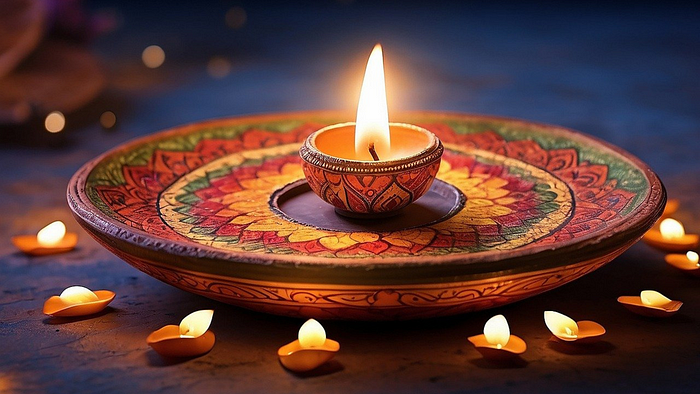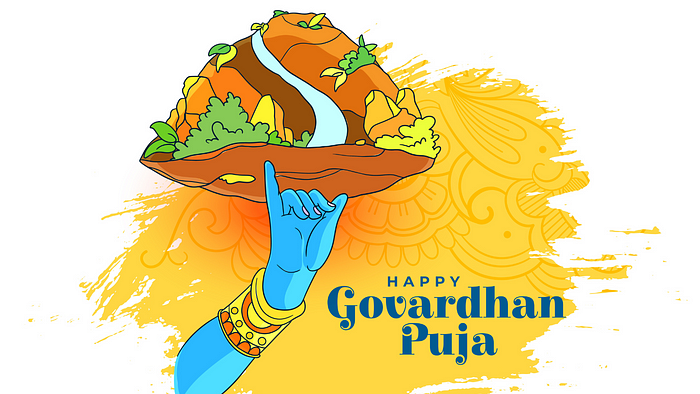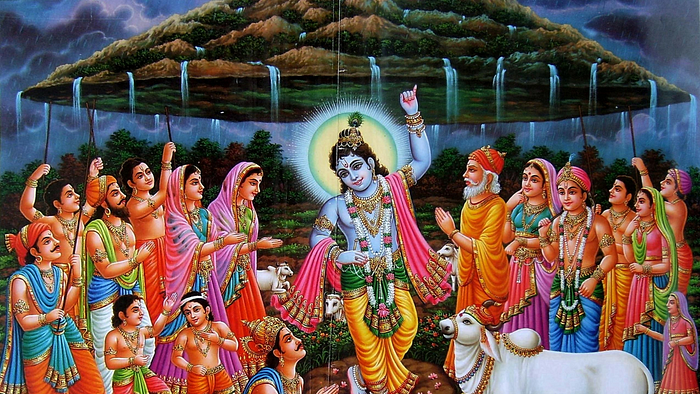A Spiritual Sojourn: Diwali and Govardhan Puja

My last week was a whirlwind of festivities and homecoming. After a week of celebrating Diwali in my hometown of Mathura, I returned to Gurugram. Mathura, too, plays a significant role in the Diwali celebrations. The fourth day of this grand festival is marked by Govardhan Puja. This unique tradition may seem fascinating to those unfamiliar with Hindu customs. On this auspicious day, Indians celebrate and worship Lord Krishna alongside the mighty Govardhan Hill, a part of the Aravali range in western India. Hindus believe that the Govardhan Hill itself is an incarnation of Krishna.

The Origin of Govardhan Puja:
The celebration of Govardhan Puja has a fascinating origin story, rooted in the childhood of Lord Krishna. In those days, the people of Braj, a region encompassing Mathura and Vrindavan, revered Indra, the god of rain and prosperity, through annual offerings. However, Indra grew arrogant and assumed himself to be the supreme power, oblivious to his role as a mere instrument in the grand cosmic order. To teach Indra a humbling lesson, young Krishna proposed an unconventional approach to the villagers: forgo the customary offerings to Indra during Diwali. This suggestion met with apprehension from the villagers, who feared Indra’s wrath if they neglected his worship. Krishna reassured them, explaining that Indra was merely fulfilling his divinely ordained duty, just like any other being in the universe.
Miracle at Govardhan Hill:
Impressed by Krishna’s wisdom, the villagers wholeheartedly agreed to his unconventional proposal. They had already prepared an abundance of food and offerings, unsure of what to do with them now. Krishna, with his characteristic smile, pointed towards the majestic Govardhan Hill and suggested that they redirect their devotion to this natural wonder. He eloquently explained that the Govardhan Hill provided them with the very foundations of their lives: the rocks to build their homes, the grass to nourish their cattle, and a protective shield against adversaries. Moreover, the hill held the clouds that brought life-giving rain to their fields. Yet, unlike Indra, the Govardhan Hill had never demanded anything in return for its selfless service. Krishna’s words resonated with the villagers, who found his reasoning irrefutable. Together, they embarked on a procession towards the Govardhan Hill, their hearts filled with gratitude and reverence for this unsung guardian of their land.

They offered heartfelt prayers and presented their carefully prepared offerings of food, creating a vibrant atmosphere of devotion. The air was filled with the joyous sounds of singing and dancing, as the villagers immersed themselves in the spirit of celebration. In that moment of collective devotion, a remarkable sight unfolded before their eyes — Lord Krishna himself descended upon them, embodying the very essence of the Govardhan Hill. With open arms and an aura of divine grace, he embraced the villagers’ prayers and offerings, leaving them awestruck and filled with profound spiritual fulfilment. This extraordinary manifestation of Krishna reinforced their faith and deepened their connection to the Govardhan Hill, forever etching this day into their hearts.
Krishna’s Divine Intervention:
News of the villagers’ newfound devotion to Govardhan Hill reached Lord Indra, who was enraged by their abandonment of his worship. Believing himself to be the supreme deity, he felt insulted that a mere child had swayed the people’s allegiance away from him. He summoned his commanders and ordered them to unleash a torrential downpour upon the Braj region, determined to punish the villagers for their defiance.
As the heavens opened up, unleashing a deluge of rain, the villages began to sink under the weight of the relentless downpour. Panic-stricken, the villagers sought refuge in the home of Krishna’s father, Maharaja Nanda, hoping for guidance and protection. Their eyes turned to little Krishna, their leader and saviour.
Krishna, with his characteristic calm and wisdom, assured the villagers that Govardhan Hill, the deity they had chosen to honour, would protect them from Indra’s wrath. He instructed them to gather the cows and bring them to the hill, where he would shield them from the storm.
With unwavering faith in Krishna’s words, the villagers followed his instructions. Krishna, using his divine powers, lifted Govardhan Hill and held it aloft, creating a vast umbrella that sheltered not only the villagers and their cattle but also the entire Braj region.
Indra’s Humility and Transformation:
For seven days, Indra raged, unleashing his fury upon the land, but his efforts were futile. Govardhan Hill, held aloft by Krishna’s divine strength, stood as an impenetrable shield, protecting the people and their land from Indra’s wrath.

Finally, exhausted and humbled, Indra acknowledged his defeat. He realized that his arrogance had blinded him to the true power of devotion and humility. He descended from the heavens, seeking forgiveness from Krishna and the villagers.
Krishna, embodying the essence of compassion and forgiveness, granted Indra’s plea. He reminded Indra that his role was not to demand worship but to serve the people and fulfil his divinely ordained duties.
Indra, humbled and enlightened, vowed to govern with humility and respect, fulfilling his role as the god of rain and prosperity. The villagers, witnessing Indra’s transformation, regained their faith in him.
Lessons of Govardhan Puja:
The story of Govardhan Puja serves as a reminder that true devotion lies not in blind obedience or fear but in understanding and appreciating the divine power that exists within all creation. It is a story of humility, forgiveness, and the triumph of unity over arrogance.
Parikrama and Spiritual Exploration:
As a gesture of respect and a plea for protection, it has become a tradition to perform a parikrama, a circumambulatory pilgrimage, around Govardhan Hill. This sacred hill is encircled by a 21-kilometer path, and upon my arrival in Mathura from Gurugram, I embarked on this spiritual journey. The captivating beauty of this place and the palpable magic in the air left me spellbound. A true gift of nature, Govardhan Hill boasts a rich diversity of vegetation and is home to a warm and welcoming community. Scattered across the landscape are numerous historical temples and serene ponds, inviting exploration and meaningful encounters.

The optimal way to immerse oneself in the charm of this locale is by exploring it on a bike, an approach I eagerly embraced. Upon arriving in Mathura, I opted for a night of rest before resuming my journey the following morning towards Goverdhan, situated approximately 25 kilometres from Mathura city.
Delights and Hospitality in Braj:
The culinary offerings were delectable, and what distinguishes Mathura from the rest is its unique sense of hospitality. In contrast to the prevailing norms, if one finds themselves lacking funds or a place to stay, there’s no cause for concern; most of the locals readily extend invitations for both food and lodging, free of charge.
A particular highlight was the gastronomic delight derived from the ongoing social functions scattered throughout the region.
Reflections on a Spiritual Pilgrimage:
Upon completing my 21-kilometre Parikrama in four hours, fatigue set in, prompting a need for sustenance. After refreshing myself, I gravitated towards a nearby spot where locals generously offered Prashad (Sacred food), partaking in the nourishing fare before taking a well-deserved rest. Subsequently, I retraced my route on my bike back home, thoroughly exhausted and ready to succumb to a restful slumber.
Click here to read the next part of this blog.
